 W
WThe Holocaust in Poland was part of the European-wide Holocaust organized by Nazi Germany and took place in German-occupied Poland. The genocide took the lives of three million Polish Jews, half of all Jews killed during the Holocaust.
 W
WAktion T4 was a campaign of mass murder by involuntary euthanasia in Nazi Germany. The term was first used in post-war trials against doctors who had been involved in the killings. The name T4 is an abbreviation of Tiergartenstraße 4, a street address of the Chancellery department set up in early 1940, in the Berlin borough of Tiergarten, which recruited and paid personnel associated with T4. Certain German physicians were authorised to select patients "deemed incurably sick, after most critical medical examination" and then administer to them a "mercy death". In October 1939, Adolf Hitler signed a "euthanasia note", backdated to 1 September 1939, which authorised his physician Karl Brandt and Reichsleiter Philipp Bouhler to begin the killing.
 W
WAryanization was the forced expulsion of Jews from business life in Nazi Germany, Axis-aligned states, and their occupied territories. It entailed the transfer of Jewish property into "Aryan" hands.
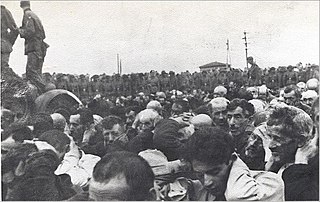 W
WThe Białystok Ghetto was a Nazi ghetto set up by the German SS between July 26 and early August 1941 in the newly formed District of Bialystok within occupied Poland. About 50,000 Jews from the vicinity of Białystok and the surrounding region were confined into a small area of the city, which was turned into the district's capital. The ghetto was split in two by the Biała River running through it. Most inmates were put to work in the slave-labor enterprises for the German war effort, primarily in large textile, shoe and chemical companies operating inside and outside its boundaries. The ghetto was liquidated in November 1943. Its inhabitants were transported in Holocaust trains to the Majdanek concentration camp and Treblinka extermination camps. Only a few hundred survived the war, either by hiding in the Polish sector of the city, escape following the Bialystok Ghetto Uprising, or by surviving the camps.
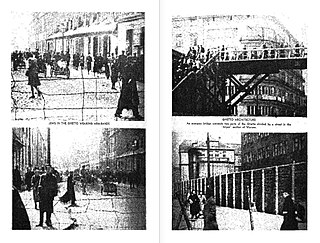 W
WThe Black Book of Polish Jewry is a 400-page report about the progress of the Holocaust in Poland published in 1943 during World War II by the American Federation for Polish Jews in cooperation with the Association of Jewish Refugees and Immigrants from Poland. It was compiled by Jacob Apenszlak with Jacob Kenner, Isaac Lewin and Moses Polakiewicz, and released by Roy Publishers of New York with an introduction by Ignacy Schwarzbart from the National Council of the Polish Republic. The book was sponsored by Eleanor Roosevelt, Albert Einstein, US Senator Robert Wagner, and other high-ranking community leaders. Historian Michael Fleming suggests it downplayed the true scale and manner of the Holocaust in an effort to elicit the empathy of its readership.
 W
WThe Blue Police, was the police during the Second World War in German-occupied Poland. The entity's official German name was Polnische Polizei im Generalgouvernement.
 W
WThe Byelorussian Auxiliary Police was a collaborationist paramilitary force established in July 1941. Staffed by local inhabitants from German-occupied Byelorussia, it had similar functions to those of the German Ordnungspolizei in other occupied territories.
 W
WThe Częstochowa Ghetto uprising was an insurrection in Poland's Częstochowa Ghetto against German occupational forces during World War II. It took place in late June 1943, resulting in some 2,000 Jews being killed.
 W
WThe Deutsche Volksliste, a Nazi Party institution, aimed to classify inhabitants of Nazi-occupied territories (1939-1945) into categories of desirability according to criteria systematised by Reichsführer-SS Heinrich Himmler. The institution originated in occupied western Poland. Similar schemes subsequently developed in Occupied France (1940-1944) and in the Reichskommissariat Ukraine (1941-1944).
 W
WEinsatzgruppen were Schutzstaffel (SS) paramilitary death squads of Nazi Germany that were responsible for mass killings, primarily by shooting, during World War II (1939–1945) in German-occupied Europe. The Einsatzgruppen had an integral role in the implementation of the so-called "Final Solution to the Jewish Question" in territories conquered by Nazi Germany, and were involved in the murder of much of the intelligentsia and cultural elite of Poland, including members of the Catholic priesthood. Almost all of the people they killed were civilians, beginning with the intelligentsia and swiftly progressing to Soviet political commissars, Jews, and Romani people, as well as actual or alleged partisans throughout Eastern Europe.
 W
WThe Einsatzgruppen Operational Situation Reports (OSRs), or ERM for the German: Die Ereignismeldung UdSSR, were dispatches of the Nazi death squads (Einsatzgruppen), which documented the progress of the Holocaust behind the German-Soviet frontier in the course of Operation Barbarossa, during World War II. The extant reports were sent between June 1941 and April 1942 to the Chief of the Security Police and the SD in Berlin, from the occupied eastern territories including modern-day Poland, Belarus, Ukraine, Russia, Moldova, and the Baltic Countries. During the Nuremberg War Crimes Trials the originals were grouped according to year and month and catalogued using a consecutive numbering system, as listed in the below table. The original photostats are held at the National Archives in Washington D.C..
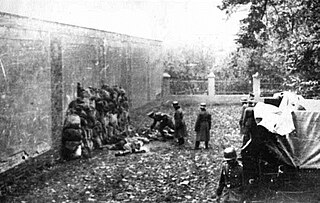 W
WDuring World War II, the Nazi German Einsatzkommandos were a sub-group of the Einsatzgruppen – up to 3,000 men total – usually composed of 500–1,000 functionaries of the SS and Gestapo, whose mission was to exterminate Jews, Polish intellectuals, Romani, and communists in the captured territories often far behind the advancing German front. Einsatzkommandos, along with Sonderkommandos, were responsible for the systematic killing of Jews during the aftermath of Operation Barbarossa, the invasion of the Soviet Union. After the war several commanders were tried in the Einsatzgruppen trial, convicted, and executed.
 W
WThe ethnic cleansing of Zamojszczyzna by Nazi Germany during World War II was carried out as part of a greater plan of forcible removal of the entire Polish populations from targeted regions of occupied Poland in preparation for the state-sponsored settlement of the ethnic German Volksdeutsche. The operation of mass expulsions from Zamojszczyzna region around the city of Zamość was carried out between November 1942 and March 1943 on direct order from Heinrich Himmler. It was preplanned by both Globocnik from Action Reinhard and Himmler, as the first stage of the eventual murderous ethnic cleansing ahead of projected Germanization of the entire General Government territory.
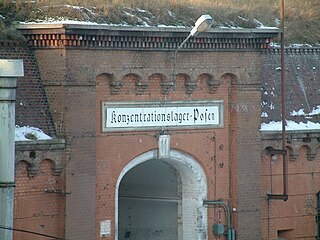 W
WFort VII, officially Konzentrationslager Posen, was a Nazi German death camp set up in Poznań in German-occupied Poland during World War II, located in one of the 19th-century forts circling the city. According to different estimates, between 4,500 and 20,000 people, mostly Poles from Poznań and the surrounding region, died while imprisoned at the camp.
 W
WGates of Tears: the Holocaust in the Lublin District is the first comprehensive study of the Holocaust in the Lublin District of Poland. It was written by David Silberklang and published in 2013 by Yad Vashem.
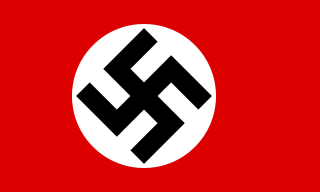 W
WThe General Government, also referred to as the General Governorate for the Occupied Polish Region, was a German zone of occupation established after the invasion of Poland by Nazi Germany, Slovakia and the Soviet Union in 1939 at the onset of World War II. The newly occupied Second Polish Republic was split into three zones: the General Government in its centre, Polish areas annexed by Nazi Germany in the west, and Polish areas annexed by the Soviet Union in the east. The territory was expanded substantially in 1941, after the German Invasion of the Soviet Union, to include the new District of Galicia.
 W
WThe Generalplan Ost, abbreviated GPO, was the Nazi German government's plan for the genocide and ethnic cleansing on a vast scale, and colonization of Central and Eastern Europe by Germans. It was to be undertaken in territories occupied by Germany during World War II. The plan was attempted during the war, resulting indirectly and directly in the deaths of millions by shootings, starvation, disease, extermination through labor, and genocide. But its full implementation was not considered practicable during the major military operations, and was prevented by Germany's defeat.
 W
WThe ghetto uprisings during World War II were a series of armed revolts against the regime of Nazi Germany between 1941 and 1943 in the newly established Jewish ghettos across Nazi-occupied Europe. Following the German and Soviet invasion of Poland in September 1939, Polish Jews were targeted from the outset. Within months inside occupied Poland, the Germans created hundreds of ghettos in which they forced the Jews to live. The new ghettos were part of the German official policy of removing Jews from public life with the aim of economic exploitation. The combination of excess numbers of inmates, unsanitary conditions and lack of food resulted in a high death rate among them. In most cities the Jewish underground resistance movements developed almost instantly, although ghettoization had severely limited their access to resources.
 W
WThe Group Thirteen network was a Jewish Nazi collaborationist organisation in the Warsaw Ghetto during the German occupation of Poland in World War II. The Thirteen took its informal name from the address of its main office at 13 Leszno Street in Warsaw. The group was founded in December 1940 and led by Abraham Gancwajch, the former head of Hashomer Hatzair in Łódź. Sanctioned by Sicherheitsdienst (SD), and also known as the Jewish Gestapo, the unit reported directly to the German Gestapo office.
 W
WHotel Polski, opened in 1808, was a hotel in Śródmieście, Warsaw, Poland, at 29 Długa street.
 W
WThe Intelligenzaktion Pommern was a Nazi German operation aimed at the eradication of the Polish intelligentsia in Pomeranian Voivodeship and the surrounding areas at the beginning of World War II. It was part of a larger genocidal Intelligenzaktion, that took place across most of Nazi-occupied western Poland in the course of Operation Tannenberg, purposed to install Nazi officials from SiPo, Kripo, Gestapo and SD at the helm of a new administrative machine.
 W
WThe Kraków-Podgórze Detention Centre is a correctional facility located at ul. Stefana Czarnieckiego 3 in Kraków, Poland, in the municipal district of Podgórze. Originally, it was a turn-of-the-century county court and revenue service, built in 1905, from design by Ferdynand Liebling. At present, it is a community branch of Detention Centre Kraków, with main building located at ul. Montelupich 7 street. The Kraków-Podgórze Detention Centre specializes in drug-and-alcohol-addiction therapy and serves also as a temporary arrest facility. It was created in 1971 as a prison for men with the holding capacity of 207. It was made into a detention facility in 1990. There's a medical clinic and a dentist on-site. Prisoners who completed the recovery program work with mentally and physically disabled clients.
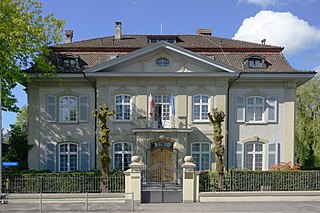 W
WŁadoś Group, Bernese Group is a name given to a group of Polish diplomats and Jewish activists who during Second World War elaborated in Switzerland a system of illegal production of Latin American passports aimed at saving European Jews from the Holocaust.
 W
WThe Lemberg Mosaic, subtitled the "Memoirs of Two who Survived the Destruction of Jewish Galicia," is a book on the Holocaust by Jakob Weiss. This work brings to light the relatively obscure history of the systematic and total destruction of Jewish Lemberg. It is presented in the format of a biography, detailing the struggle for survival of four families in the backdrop of two back-to-back invasions of the city and surrounding region by both the Soviets (1939) and the Germans (1941).
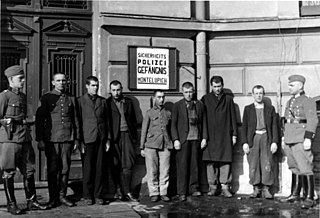 W
WThe Montelupich prison, so called from the street in which it is located, the ulica Montelupich, is a historic prison in Kraków from early 20th century, which was used by the Gestapo in World War II. It is universally recognized as "one of the most terrible Nazi prisons in [occupied] Poland". The Gestapo took over the facility from the German Sicherheitspolizei at the end of March 1941. One of the Nazi officials responsible for overseeing the Montelupich Prison was Ludwig Hahn.
 W
WThe Nachtigall Battalion, also known as the Ukrainian Nightingale Battalion Group, or officially as Special Group Nachtigall, was the subunit under command of the German Abwehr special operations unit Lehrregiment "Brandenburg" z.b.V. 800. Along with the Roland Battalion it was one of two military units formed February 25, 1941 by head of the Abwehr Wilhelm Franz Canaris, which sanctioned the creation of the "Ukrainian Legion" under German command. It was composed of volunteer Ukrainians operating under Stephan Bandera's Organization of Ukrainian Nationalists (OUN) orders.
 W
WCrimes against the Polish nation committed by Nazi Germany and Axis collaborationist forces during the invasion of Poland, along with auxiliary battalions during the subsequent occupation of Poland in World War II, consisted of the murder of millions of ethnic Poles and the systematic extermination of Jewish Poles. The Germans justified these genocides on the basis of Nazi racial theory, which regarded Poles and other Slavic peoples as racially inferior Untermenschen and depicted Jews as a constant threat. By 1942, the Nazi Germans were implementing their plan to kill every Jew in German-occupied Europe, and had also developed plans to eliminate the Polish people through mass murder, ethnic cleansing, enslavement and extermination through labor, and assimilation into German identity of a small minority of Poles deemed "racially valuable". During World War II, the Germans not only murdered millions of Poles, but ethnically cleansed millions more through forced deportation to make room for “racially superior” German settlers. The genocides claimed the lives of 2.7 to 3 million Polish Jews and 1.8 to 2.77 million non-Jewish ethnic Poles, according to various sources such as Poland's Institute of National Remembrance.
 W
WThe Nisko Plan was an operation to deport Jews to the Lublin District of the General Governorate of occupied Poland in 1939. Organized by Nazi Germany, the plan was cancelled in early 1940.
 W
WThe occupation of Poland by Nazi Germany and the Soviet Union during World War II (1939–1945) began with the German-Soviet invasion of Poland in September 1939, and it was formally concluded with the defeat of Germany by the Allies in May 1945. Throughout the entire course of the occupation, the territory of Poland was divided between Nazi Germany and the Soviet Union (USSR) both of which intended to eradicate Poland's culture and subjugate its people. In the summer-autumn of 1941, the lands which were annexed by the Soviets were overrun by Germany in the course of the initially successful German attack on the USSR. After a few years of fighting, the Red Army drove the German forces out of the USSR and crossed into Poland from the rest of Central and Eastern Europe.
 W
WThe Order Police battalions were militarised formations of the German Order Police during the Nazi era. During World War II, they were subordinated to the SS and deployed in German-occupied areas, specifically the Army Group Rear Areas and territories under German civilian administration. Alongside detachments from the Einsatzgruppen and the Waffen-SS, these units perpetrated mass murder of the Jewish population and were responsible for large-scale crimes against humanity targeting civilian populations.
 W
WOstbahn in the General Government, were the Nazi German railways in occupied Poland during World War II, subordinated to the General Directorate of Eastern Railways in occupied Kraków; a branch of the Deutsche Reichsbahn National Railway of Germany in the newly created Generalgouvernement territory under Hans Frank. The trains were used to cleanse and resettle interwar Poland with the German-speaking colonists in the name of "Lebensraum", and played an essential role in the mass deportations of Jews to extermination camps during the Holocaust.
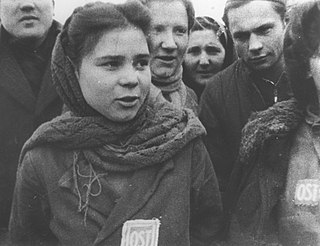 W
WOstindustrie GmbH was one of many industrial projects set up by the Nazi German Schutzstaffel (SS) using Jewish and Polish forced labor during World War II. Founded in March 1943 in German-occupied Poland, Osti operated confiscated Jewish and Polish prewar industrial enterprises, including foundries, textile plants, quarries and glassworks. Osti was headed by SS-Obersturmführer Max Horn, who was subordinated directly to Obergruppenführer Oswald Pohl of the SS Main Economic and Administrative Office. At its height, some 16,000 Jews and 1,000 Poles worked for the company, interned in a network of labor and concentration camps in the Lublin District of the semi-colonial General Government territory.
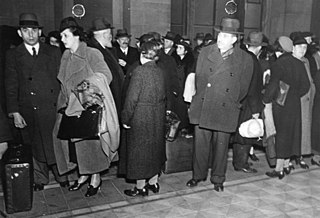 W
WPolenaktion was the arrest and expulsion of about 17,000 Polish Jews living in Nazi Germany in October 1938. These deportations, ordered by SS officer and head of the Gestapo Reinhard Heydrich, displaced thousands of Polish Jews along the Germany–Poland border.
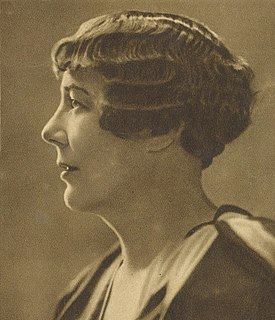 W
WProtest! was a clandestine leaflet issued in 1942 as a protest by Polish Catholics against the mass murder of Jews in German-occupied Poland.
 W
WRaczyński's Note, dated December 10, 1942, and signed by Minister of Foreign Affairs Edward Raczyński, was the official diplomatic note from the government of Poland in exile regarding the extermination of the Jews in German-occupied Poland. Sent to the foreign ministers of the Allies, it was the first official report on the Holocaust to inform the Western public about these crimes. It identified Treblinka, Bełżec and Sobibór by name as extermination camps. It was also the first official speech of one of the governments of Nazi-occupied Europe in defense of all Jews persecuted by Germany – not only citizens of their country.
 W
WPolish Jews were the primary victims of the German-organized Holocaust in Poland. Throughout the German occupation of Poland, many Poles rescued Jews from the Holocaust, in the process risking their lives – and the lives of their families. Poles were, by nationality, the most numerous persons who rescued Jews during the Holocaust. To date, 7,112 ethnic Poles have been recognized by the State of Israel as Righteous among the Nations – more, by far, than the citizens of any other country.
 W
WOskar Schindler was a German industrialist and a member of the Nazi Party who is credited with saving the lives of 1,200 Jews during the Holocaust by employing them in his enamelware and ammunitions factories in occupied Poland and the Protectorate of Bohemia and Moravia. He is the subject of the 1982 novel Schindler's Ark and its 1993 film adaptation, Schindler's List, which reflected his life as an opportunist initially motivated by profit, who came to show extraordinary initiative, tenacity, courage, and dedication to save the lives of his Jewish employees.
 W
WSchutzmannschaft-Brigade Siegling was a Belarusian Auxiliary Police brigade formed by Nazi Germany in July 1944 in East Prussia, from members of six local volunteer battalions of Schutzmannschaft following the Soviet Operation Bagration. The six retreating collaborationist units who joined Siegling included Bataillon 57 (ukrainische), Bataillon 60 (weißruthenische), Bataillon 61, 62, 63 (ukrainische), and Bataillon 64 (weißruthenische).
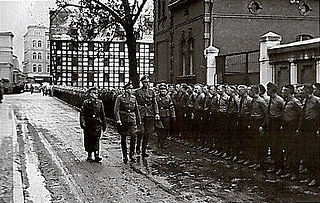 W
WSelbstschutz is the name given to different iterations of ethnic-German self-protection units formed both after the First World War and in the lead-up to the Second World War.
 W
WSobibor was an extermination camp built and operated by Nazi Germany as part of Operation Reinhard. It was located in the forest near the village of Sobibór in the General Government region of German-occupied Poland.
 W
WSonderaktion 1005, also called Aktion 1005, or Enterdungsaktion, began in May 1942 during World War II to hide any evidence that people had been murdered by Nazi Germany in German-occupied Poland and Soviet Union. The project, which was conducted in secrecy from 1942 to 1944, focused on concealing evidence of mass murder at the Operation Reinhard killing centres, as well as at other sites. Groups of Sonderkommando prisoners, officially called Leichenkommandos, were used to exhume mass graves and burn the bodies; inmates were often put in chains to prevent them from escaping.
 W
WSpecial Prosecution Book-Poland was the proscription list prepared by the Germans immediately before the onset of war, that identified more than 61,000 members of Polish elites: activists, intelligentsia, scholars, actors, former officers, and prominent others, who were to be interned or shot on the spot upon their identification following the invasion.
 W
WStaging Point is one of five drawings depicting the life of children in the Warsaw ghetto in the collection of the Jewish Historical Institute, Warsaw. The author of the drawings is an unknown draftsman, but they are signed "Rozenfeld". The drawing was made, most probably, between autumn and winter of 1941 and commissioned as part of the Ringelblum Archive - which has been inscribed in the UNESCO Memory of the World Register in 1999.
 W
WSzmalcownik ; in English, also sometimes spelled shmaltsovnik) is a pejorative Polish slang expression that originated during the Holocaust in Poland in World War II and refers to a person who blackmailed Jews who were in hiding, or who blackmailed Poles who aided Jews during the German occupation. By stripping Jews of their financial resources, blackmailers added substantially to the danger that Jews and their rescuers faced and increased their chances of getting caught and killed.
 W
WThe Black Book of Poland is a 750-page report published in 1942 by the Ministry of Information of the Polish government-in-exile, describing atrocities committed by Germany in occupied Poland in the 22 months between the invasion of Poland in September 1939, and the end of June 1941.
 W
WThe Holocaust in East Upper Silesia resulted in the murder of most of the Jews living in East Upper Silesia during World War II. It is best known as the site of Auschwitz concentration camp, but it also hosted many of the forced-labor camps of Organization Schmelt and seventeen ghettos, including Sosnowiec Ghetto, Będzin Ghetto, and Dąbrowa Górnicza Ghetto. Part of the region had been in Poland before World War II and other parts in Germany.
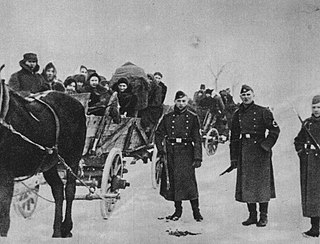 W
WDuring the Holocaust, 99% of the Jews from Lublin District in the General Governorate of German-occupied Poland were murdered, along with thousands of Jews who had been deported to Lublin from elsewhere. There were three extermination camps in Lublin District, Sobibor, Belzec, and Majdanek.
 W
WThe Mass Extermination of Jews in German Occupied Poland was a brochure published by the Polish government-in-exile in 1943 to disseminate the text of Raczyński's Note of 10 December 1942. It was the first official information to the Western general public about the Holocaust in German-occupied Poland.
 W
WThe Polish White Book is a semi-official name of a series of comprehensive reports published during World War II by the Ministry of Information of the Polish government-in-exile in London, England, dealing with Polish-German relations before and after the 1939 German-Soviet aggression against Poland. Each publication, released in English, French, German and Polish between 1940 and 1941, consisted of official documents and affidavits, supplemented with an overview by the Ministry. Notably, the Polish White Book was released in parallel with The Black Book of Poland series by G.P. Putnam's Sons of New York, published in London by Hutchinson & Co under a differing title in 1942.
 W
WTöbbens and Schultz was a Nazi German textile manufacturing conglomerate making German uniforms, socks and garments in the Warsaw Ghetto and elsewhere, during the occupation of Poland in World War II. It was owned and operated by two major war profiteers: Fritz Emil Schultz from Danzig, and a convicted war criminal, Walter C. Többens.
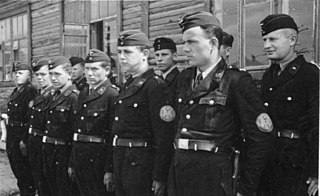 W
WThe Ukrainische Hilfspolizei or the Ukrainian Auxiliary Police was the official title of the local police formation set up by Nazi Germany during World War II in Reichskommissariat Ukraine, shortly after the German conquest of the Ukrainian Soviet Socialist Republic in Operation Barbarossa against the Soviet Union, Germany's former co-belligerent in the invasion of Poland.
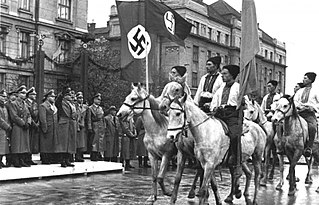 W
WCollaboration with Nazi Germany in German-occupied Ukraine took place during the occupation of what is now Ukraine by Nazi Germany in World War II. The new territorial divisions included District of Galicia and Reichskommissariat Ukraine, which covered both the south-eastern territories of the Second Polish Republic and the Ukrainian Soviet Socialist Republic, across the former borders.
 W
WUmschlagplatz was the term used during The Holocaust to denote the holding areas adjacent to railway stations in occupied Poland where Jews from ghettos were assembled for deportation to Nazi death camps. The largest collection point was in Warsaw next to the Warsaw Ghetto. In 1942 between 254,000 – 265,000 Jews passed through the Warsaw Umschlagplatz on their way to the Treblinka extermination camp during Operation Reinhard, the deadliest phase of the Holocaust in Poland. Often those awaiting the arrival of Holocaust trains, were held at the Umschlagplatz overnight. Other examples of Umschlagplatz include the one at Radogoszcz station - adjacent to the Łódź Ghetto - where people were sent to Chełmno extermination camp and Auschwitz.
 W
WIn the best-known photograph taken during the 1943 Warsaw Ghetto uprising, a boy holds his hands over his head while SS-Rottenführer Josef Blösche points a submachine gun in his direction. The boy and others hid in a bunker during the final liquidation of the ghetto, but they were caught and forced out by German troops. After the photograph was taken, all of the Jews in the photograph were marched to the Umschlagplatz and deported to Majdanek extermination camp or Treblinka. The exact location and the photographer are not known, and Blösche is the only person in the photograph who can be identified with certainty. The image is one of the most iconic photographs of the Holocaust, and the boy came to represent children in the Holocaust, as well as all Jewish victims.
 W
WThe Warsaw Ghetto Museum is a history museum in Warsaw currently under construction. It will open in 2023, on the 80th anniversary commemoration of the Warsaw Ghetto Uprising. The museum will be located in the buildings of the former Bersohn and Bauman Children's Hospital in Warsaw at 51 Śliska Street and 60 Sienna Street. On October 19, 2018 Museum director, Polish-Jewish historian Albert Stankowski received a key to the property from a government official and signed a long-term lease during a ceremony at the future museum site. Its chief historian is Daniel Blatman.
 W
WThe Warsaw Ghetto Uprising was the 1943 act of Jewish resistance in the Warsaw Ghetto in German-occupied Poland during World War II to oppose Nazi Germany's final effort to transport the remaining ghetto population to Majdanek and Treblinka death camps.
 W
WAround six million Polish citizens, are estimated to have perished during World War II. Most were civilians killed by the actions of Nazi Germany and the Soviet Union. At the International Military Tribunal held in Nuremberg, Germany, in 1945–46, three categories of wartime criminality were juridically established: waging a war of aggression; war crimes; and crimes against humanity. These three crimes in international law were for the first time, from the end of the war, categorized as violations of fundamental human values and norms. These crimes were committed in occupied Poland on a tremendous scale.
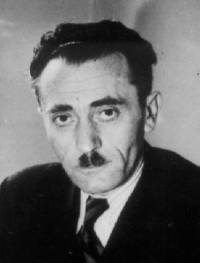 W
WSzmul Zygielbojm was a Polish Jewish socialist politician, Bund trade-union activist, and member of the National Council of the Polish government-in-exile.